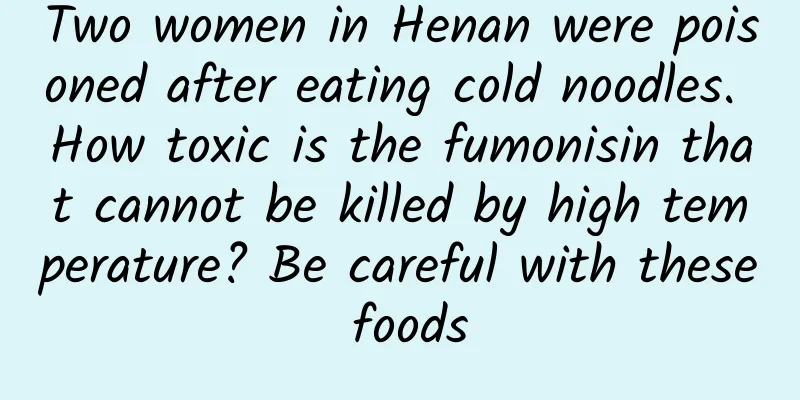Two women in Henan were poisoned after eating cold noodles. How toxic is the fumonisin that cannot be killed by high temperature? Be careful with these foods

|
According to media reports, on July 3, two women in Yongcheng City, Henan Province, were poisoned after eating cold noodles. One died and the other was still in the intensive care unit. The doctor told the family that the two were poisoned by fumonisin. On July 15, the Shangqiu Municipal Party Committee's Cyberspace Affairs Office said that relevant departments were investigating and would inform the public once the investigation was completed. Copyrighted images from the gallery, unauthorized reproduction, please contact the original author Food poisoning incidents caused by fumonisin have occurred in the past, and they often occur in summer and autumn. Public reports show: In October 2020, a family of nine in Heilongjiang was poisoned after eating homemade "sour soup" during a dinner at home. After epidemiological investigation and sampling and testing by the CDC, high concentrations of fumonisin were detected in the corn flour. In June 2021, a 7-year-old girl suffered from alfalfa acid poisoning and multiple organ failure after eating black fungus that had been soaked for two days. What exactly is the culprit in this case, fumonisin, and why is it so potent? What is fumonisin Bongkrekic acid (BA) is a toxin produced by Pseudomonas cerebrovenenans subspecies that can cause food poisoning. Ingestion of food contaminated by this toxin can cause poisoning in humans or animals, and in severe cases, death. This toxin is produced in soaked fungus, fermented cornmeal products, spoiled fresh white fungus and other foods. In addition, glutinous rice dumplings, potato vermicelli, sweet potato starch and other foods in life contain this bacteria, so these foods must not be eaten after they are spoiled. Copyrighted images from the gallery, unauthorized reproduction, please contact the original author High temperature cannot kill fumonisin toxin Many fungi contain nutrients and can serve as culture media for bacteria. When dry, microorganisms cannot grow. Once soaked in water, under high ambient temperature, they will inevitably breed a variety of microorganisms and become culture media. A pathogenic bacterium called "Pseudomonas cerebrovenans" will produce a toxin called "fumonisin", which is very toxic. This toxin is heat-resistant and cannot be destroyed by general cooking methods. Most toxins cannot be reduced or eliminated by high temperatures, which means that boiling spoiled food can still cause vomiting, diarrhea, food poisoning, etc. What are the symptoms of fumonisin poisoning? Symptoms of poisoning include upper abdominal discomfort, nausea, vomiting (vomiting stomach contents, coffee-colored in severe cases), mild diarrhea, dizziness, general weakness, etc. 2 to 24 hours after eating. In severe cases, yellow skin, hepatosplenomegaly, subcutaneous hemorrhage, hematemesis, hematuria, oliguria, confusion, irritability, convulsions, seizures, shock, etc. may occur. The body temperature generally does not rise, and the mortality rate is as high as 40% to 100%. First aid measures: Induce vomiting immediately by hand or medicine, take activated charcoal orally after vomiting, and go to hospital for treatment as soon as possible. Anyone who has eaten the same food as the patient, regardless of whether they are sick or not, should be sent to the hospital for observation and treatment. Moreover, there is no specific medicine for fumonisin at present, and the only treatment is symptomatic treatment. If the symptoms cannot be relieved after vomiting and gastric lavage, plasma exchange is required to expel the toxins. If the toxins have reached various organs and medical treatment is not timely, it is likely to cause irreversible damage and endanger the patient's life. How can we avoid fumonisin poisoning? Poisoning prevention: It is strictly forbidden to use soaked or moldy corn to make food. When preparing fermented cereal foods at home, the water should be changed frequently to maintain hygiene and ensure that the food does not produce odor. The best preventive measure is not to make or eat fermented rice flour. In addition, fungus is one of the most common foods that cause fumonisin poisoning. Here are some suggestions for preventing poisoning: Copyrighted images from the gallery, unauthorized reproduction, please contact the original author 1. It is recommended to soak the black fungus for a short time each time for the amount to be consumed in the meal, and do not eat the black fungus soaked overnight. 2. If you find any peculiar smell or feel mucus when touching the black fungus after soaking, you should discard it immediately. 3. Maintain a good kitchen hygiene environment, do not leave leftovers, wash dishes in time, and do not leave any food residues. |
<<: The great secret of the boat, the painting tells the story of the rudder and oars!
Recommend
256G or 512G? There are some tricks to choosing mobile phone memory
In order to meet the needs of users for storage, ...
Common properties for Android development
1. Add spaces between text in android string.xml ...
The second phase of the advanced watercolor illustration course of Yi Qiqi will end in June 2021 [good quality]
The second phase of the advanced watercolor illus...
Code practice for handling i18n international telephone area codes
Preface Last week, I was busy with the internatio...
How much does Baidu bidding hosting cost per month?
As the saying goes, "Know yourself and know ...
Baidu Double 12 Marketing Guide
Double Eleven has just passed, and we are about t...
A seasonal delicacy that you cannot miss, a spring in one bite
Review expert: Li Guangwang, Director of the Natu...
KIET: Chinese electric vehicles will account for 33.1% of the Korean market in 2024
A report released this month by the Korea Institu...
The ups and downs of the stock market: all caused by WeChat groups and Moments
This new bull market in A-shares started from 2,0...
From 47% to 80%, Ctrip Hotel APP Fluency Improvement Practice
Author: Jin, senior R&D manager at Ctrip, foc...
Outrageous! Are crabs causing havoc in blue carbon storage?
Recently, the Yantai Coastal Research Institute o...
SAIC's "Internet × New Energy" strategic upgrade extends to B-class vehicles to form full coverage
SAIC's "Internet × New Energy" strat...
Detailed explanation of Tik Tok information flow delivery strategy!
Nowadays, more and more companies and projects ar...
Zhang Chaoyang: TV series are still the "staple food" of Sohu Video
January 30 (Reporter Zhang Zhichang) After the fu...
Behind the acquisition rumors: BlackBerry is still valuable
Recently, there were rumors that Samsung wanted t...









